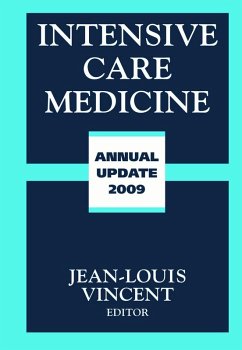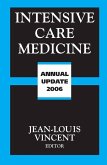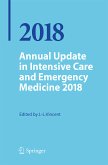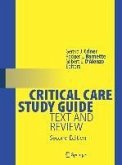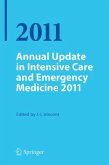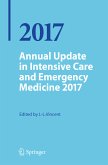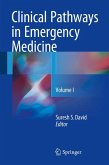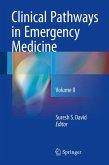Intensive Care Medicine (eBook, PDF)
Annual Update 2009
96,29 €
inkl. MwSt.
Sofort per Download lieferbar
Intensive Care Medicine (eBook, PDF)
Annual Update 2009
- Format: PDF
- Merkliste
- Auf die Merkliste
- Bewerten Bewerten
- Teilen
- Produkt teilen
- Produkterinnerung
- Produkterinnerung

Bitte loggen Sie sich zunächst in Ihr Kundenkonto ein oder registrieren Sie sich bei
bücher.de, um das eBook-Abo tolino select nutzen zu können.
Hier können Sie sich einloggen
Hier können Sie sich einloggen
Sie sind bereits eingeloggt. Klicken Sie auf 2. tolino select Abo, um fortzufahren.

Bitte loggen Sie sich zunächst in Ihr Kundenkonto ein oder registrieren Sie sich bei bücher.de, um das eBook-Abo tolino select nutzen zu können.
The Update compiles the most recent developments in experimental and clinical research and practice in one comprehensive reference book. The chapters are written by well recognized experts in the field of intensive care and emergency medicine. It is addressed to everyone involved in internal medicine, anesthesia, surgery, pediatrics, intensive care and emergency medicine.
- Geräte: PC
- ohne Kopierschutz
- eBook Hilfe
- Größe: 19.11MB
- Upload möglich
Andere Kunden interessierten sich auch für
![Intensive Care Medicine (eBook, PDF) Intensive Care Medicine (eBook, PDF)]() Intensive Care Medicine (eBook, PDF)96,29 €
Intensive Care Medicine (eBook, PDF)96,29 €![Annual Update in Intensive Care and Emergency Medicine 2018 (eBook, PDF) Annual Update in Intensive Care and Emergency Medicine 2018 (eBook, PDF)]() Annual Update in Intensive Care and Emergency Medicine 2018 (eBook, PDF)181,89 €
Annual Update in Intensive Care and Emergency Medicine 2018 (eBook, PDF)181,89 €![Critical Care Study Guide (eBook, PDF) Critical Care Study Guide (eBook, PDF)]() Critical Care Study Guide (eBook, PDF)96,29 €
Critical Care Study Guide (eBook, PDF)96,29 €![Annual Update in Intensive Care and Emergency Medicine 2011 (eBook, PDF) Annual Update in Intensive Care and Emergency Medicine 2011 (eBook, PDF)]() Annual Update in Intensive Care and Emergency Medicine 2011 (eBook, PDF)110,95 €
Annual Update in Intensive Care and Emergency Medicine 2011 (eBook, PDF)110,95 €![Annual Update in Intensive Care and Emergency Medicine 2017 (eBook, PDF) Annual Update in Intensive Care and Emergency Medicine 2017 (eBook, PDF)]() Annual Update in Intensive Care and Emergency Medicine 2017 (eBook, PDF)149,79 €
Annual Update in Intensive Care and Emergency Medicine 2017 (eBook, PDF)149,79 €![Clinical Pathways in Emergency Medicine (eBook, PDF) Clinical Pathways in Emergency Medicine (eBook, PDF)]() Clinical Pathways in Emergency Medicine (eBook, PDF)160,49 €
Clinical Pathways in Emergency Medicine (eBook, PDF)160,49 €![Clinical Pathways in Emergency Medicine (eBook, PDF) Clinical Pathways in Emergency Medicine (eBook, PDF)]() Clinical Pathways in Emergency Medicine (eBook, PDF)106,99 €
Clinical Pathways in Emergency Medicine (eBook, PDF)106,99 €-
-
-
The Update compiles the most recent developments in experimental and clinical research and practice in one comprehensive reference book. The chapters are written by well recognized experts in the field of intensive care and emergency medicine. It is addressed to everyone involved in internal medicine, anesthesia, surgery, pediatrics, intensive care and emergency medicine.
Produktdetails
- Produktdetails
- Verlag: Springer New York
- Erscheinungstermin: 14. März 2010
- Englisch
- ISBN-13: 9780387922782
- Artikelnr.: 37289069
- Verlag: Springer New York
- Erscheinungstermin: 14. März 2010
- Englisch
- ISBN-13: 9780387922782
- Artikelnr.: 37289069
Genomics and Proteomics.- Inflammatory Response.- Current and Future Management Sepsis.- Proposed Targets for New Therapies.- Septic Shock.- Intravenous Fluids.- Hemodynamic Support.- Airway Management.- Mechanical Ventilation.- Respiratory Monitoring.- Perioperative Management.- Cardiac Function.- Cardiopulmonary Resuscitation.- Renal Function.- Hepato-splanchnic Function.- Nutrition.- Glucose Control.- Adrenal Function.- Coagulation.- Neurological Aspects.- Malignancies.- Drug Dosing.- Sedation and Analgesia.- ICU Management.- End-of-Life Issues.
Genomics and Proteomics.- Rethinking Sepsis: New Insights from Gene Expression Profiling Studies.- Mitochondrial Genetics and Sepsis.- Lung Proteomics in Intensive Care.- Inflammatory Response.- The Host Response to Sepsis.- Endotoxin Tolerance: Mechanisms and Clinical Applicability.- Oxidative Stress and Endothelial Dysfunction during Sepsis.- Measurement of Carbon Monoxide: From Bench to Bedside.- Monitoring Immune Dysfunction in Septic Patients: Toward Tailored Immunotherapy.- Current and Future Management of Sepsis.- Source Control in the ICU.- IgM-enriched Immunoglobulins in Sepsis.- Clarithromycin: A Promising Immunomodulator in Sepsis.- High-flow Hemofiltration as an Adjunctive Therapy in Sepsis.- Economic and Social Burden of Severe Sepsis.- Proposed Targets for New Therapies.- Lymphocyte Apoptosis in Sepsis and Potential Anti-apoptotic Strategies.- The Pivotal Role of Beta-adrenoreceptors in Critical Illness Pathophysiology.- Non-septic Acute Lung Injury and Inflammation: Role of TLR4.- Hydrogen Sulfide: A Metabolic Modulator and a Protective Agent in Animal Models of Reperfusion Injury.- Septic Shock.- 'Myocardial Depression' or' septic Cardiomyopathy'?.- Determinants of Tissue PCO2 in Shock and Sepsis: Relationship to the Microcirculation.- Refining the Tools for Early Goal-directed Therapy in Septic Shock.- Intravenous Fluids.- Hyperchloremic Metabolic Acidosis: More than Just a Simple Dilutional Effect.- Old versus New Starches: What do We Know about their Differences?.- Impact of Hydroxyethyl Starch on Renal Function.- Rational Approach to Fluid Therapy in Acute Diabetic Ketoacidosis.- Hemodynamic Support.- Cardiac Filling Volumes and Pressures in Assessing Preload Responsiveness during Fluid Challenges.- Update on preload indexes: More volume than pressure.- Monitoring Arterial Blood Pressure and Cardiac Output using Central or Peripheral Arterial Pressure Waveforms.- Intrathoracic Pressure Regulation for the Treatment of Hypotension.- Functional Hemodynamic Monitoring: A Personal Perspective.- Airway Management.- Endotracheal Intubation in the ICU.- Pediatric Advanced Airway Management Training for Non-anesthesia Residents.- Automatic Tube Compensation in the Weaning Process.- Mechanical Ventilation.- Extracorporeal Membrane Oxygenation for Cardiac and Pulmonary Indications: Improving Patient Safety.- Patient-ventilator Interaction during Non-invasive Ventilation.- Variable Mechanical Ventilation: Breaking the Monotony.- Life-threatening Asthma: Focus on Lung Protection.- Respiratory Monitoring.- Bedside Monitoring of Diaphragm Electrical Activity during Mechanical Ventilation.- Electrical Impedance Tomography.- Regional Ventilation Delay Index: Detection of Tidal Recruitment using Electrical Impedance Tomography.- Different Approaches to the Analysis of Volumetric Capnography.- Variation in Extravascular Lung Water in ALI/ARDS Patients using Open Lung Strategy.- Clinical Utility of Extravascular Lung Water Measurements.- Perioperative Management.- Rationalizing the Use of Surgical Critical Care: The Role of Cardiopulmonary Exercise Testing.- Advanced Minimally Invasive Hemodynamic Monitoring of the High-risk Major Surgery Patient.- Post-pneumonectomy Pulmonary Edema.- The Role of Phenylephrine in Perioperative Medicine.- Role of the Calcium Sensitizer, Levosimendan, in Perioperative Intensive Care Medicine.- Inhaled Nitric Oxide Therapy in Adult Cardiac Surgery.- Cardiac Function.- Use of Natriuretic Peptides in the Emergency Department and the ICU.- Abnormalities of the ST Segment.- Functional Mitral Regurgitation in the Critically Ill.- Cardiopulmonary Resuscitation.- Feedback to Improve the Quality of CPR.- The Post-cardiac Arrest Syndrome.- Use of a Standardized Treatment Protocol for Post-cardiac Resuscitation Care.- Therapeutic Hypothermia after Cardiac Arrest.- Renal Function.- Biomarkers of Acute Kidney Injury in Critical Illness.- The Role of Biomarkers in Cardiac Surgery-associated Acute Kidney Inju
Genomics and Proteomics.- Inflammatory Response.- Current and Future Management Sepsis.- Proposed Targets for New Therapies.- Septic Shock.- Intravenous Fluids.- Hemodynamic Support.- Airway Management.- Mechanical Ventilation.- Respiratory Monitoring.- Perioperative Management.- Cardiac Function.- Cardiopulmonary Resuscitation.- Renal Function.- Hepato-splanchnic Function.- Nutrition.- Glucose Control.- Adrenal Function.- Coagulation.- Neurological Aspects.- Malignancies.- Drug Dosing.- Sedation and Analgesia.- ICU Management.- End-of-Life Issues.
Genomics and Proteomics.- Rethinking Sepsis: New Insights from Gene Expression Profiling Studies.- Mitochondrial Genetics and Sepsis.- Lung Proteomics in Intensive Care.- Inflammatory Response.- The Host Response to Sepsis.- Endotoxin Tolerance: Mechanisms and Clinical Applicability.- Oxidative Stress and Endothelial Dysfunction during Sepsis.- Measurement of Carbon Monoxide: From Bench to Bedside.- Monitoring Immune Dysfunction in Septic Patients: Toward Tailored Immunotherapy.- Current and Future Management of Sepsis.- Source Control in the ICU.- IgM-enriched Immunoglobulins in Sepsis.- Clarithromycin: A Promising Immunomodulator in Sepsis.- High-flow Hemofiltration as an Adjunctive Therapy in Sepsis.- Economic and Social Burden of Severe Sepsis.- Proposed Targets for New Therapies.- Lymphocyte Apoptosis in Sepsis and Potential Anti-apoptotic Strategies.- The Pivotal Role of Beta-adrenoreceptors in Critical Illness Pathophysiology.- Non-septic Acute Lung Injury and Inflammation: Role of TLR4.- Hydrogen Sulfide: A Metabolic Modulator and a Protective Agent in Animal Models of Reperfusion Injury.- Septic Shock.- 'Myocardial Depression' or' septic Cardiomyopathy'?.- Determinants of Tissue PCO2 in Shock and Sepsis: Relationship to the Microcirculation.- Refining the Tools for Early Goal-directed Therapy in Septic Shock.- Intravenous Fluids.- Hyperchloremic Metabolic Acidosis: More than Just a Simple Dilutional Effect.- Old versus New Starches: What do We Know about their Differences?.- Impact of Hydroxyethyl Starch on Renal Function.- Rational Approach to Fluid Therapy in Acute Diabetic Ketoacidosis.- Hemodynamic Support.- Cardiac Filling Volumes and Pressures in Assessing Preload Responsiveness during Fluid Challenges.- Update on preload indexes: More volume than pressure.- Monitoring Arterial Blood Pressure and Cardiac Output using Central or Peripheral Arterial Pressure Waveforms.- Intrathoracic Pressure Regulation for the Treatment of Hypotension.- Functional Hemodynamic Monitoring: A Personal Perspective.- Airway Management.- Endotracheal Intubation in the ICU.- Pediatric Advanced Airway Management Training for Non-anesthesia Residents.- Automatic Tube Compensation in the Weaning Process.- Mechanical Ventilation.- Extracorporeal Membrane Oxygenation for Cardiac and Pulmonary Indications: Improving Patient Safety.- Patient-ventilator Interaction during Non-invasive Ventilation.- Variable Mechanical Ventilation: Breaking the Monotony.- Life-threatening Asthma: Focus on Lung Protection.- Respiratory Monitoring.- Bedside Monitoring of Diaphragm Electrical Activity during Mechanical Ventilation.- Electrical Impedance Tomography.- Regional Ventilation Delay Index: Detection of Tidal Recruitment using Electrical Impedance Tomography.- Different Approaches to the Analysis of Volumetric Capnography.- Variation in Extravascular Lung Water in ALI/ARDS Patients using Open Lung Strategy.- Clinical Utility of Extravascular Lung Water Measurements.- Perioperative Management.- Rationalizing the Use of Surgical Critical Care: The Role of Cardiopulmonary Exercise Testing.- Advanced Minimally Invasive Hemodynamic Monitoring of the High-risk Major Surgery Patient.- Post-pneumonectomy Pulmonary Edema.- The Role of Phenylephrine in Perioperative Medicine.- Role of the Calcium Sensitizer, Levosimendan, in Perioperative Intensive Care Medicine.- Inhaled Nitric Oxide Therapy in Adult Cardiac Surgery.- Cardiac Function.- Use of Natriuretic Peptides in the Emergency Department and the ICU.- Abnormalities of the ST Segment.- Functional Mitral Regurgitation in the Critically Ill.- Cardiopulmonary Resuscitation.- Feedback to Improve the Quality of CPR.- The Post-cardiac Arrest Syndrome.- Use of a Standardized Treatment Protocol for Post-cardiac Resuscitation Care.- Therapeutic Hypothermia after Cardiac Arrest.- Renal Function.- Biomarkers of Acute Kidney Injury in Critical Illness.- The Role of Biomarkers in Cardiac Surgery-associated Acute Kidney Inju
